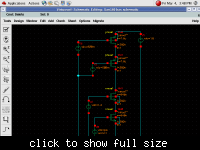Ravinder487
Full Member level 3
- Joined
- Jul 9, 2010
- Messages
- 169
- Helped
- 0
- Reputation
- 0
- Reaction score
- 0
- Trophy points
- 1,296
- Location
- Bangalore, India
- Activity points
- 2,469
Hi all,
I'm trying to design Cascode amplifier(with cascode current mirror as load) in 180nm technology(@vdd=1.8 ) with following specifications
voltage gain 50V/V output swing .6v and ouput impedance of 4Mohm.
I first started by assuming overdrive voltages of all the transistors are same,so with this assumption my Vod is coming to be .3V.With Vod=.3 and Vth=500m my VGS<800m.From my slewrate and powerdissipation constraints I have fixed my bias current.With bias current and VGS(800m) in hand I've calculated the W/L of all the transistors.
With L=180nm I'm getting a gain of 10.2.So I doubled L(and also W in proportion) of all the transistors but my gain isn't getting 4times!! (WHY??)
And with this method I'm getting very low input swing(around 70mV).
How to find ouput resistance of Cascode amplifier?
I'm trying to design Cascode amplifier(with cascode current mirror as load) in 180nm technology(@vdd=1.8 ) with following specifications
voltage gain 50V/V output swing .6v and ouput impedance of 4Mohm.
I first started by assuming overdrive voltages of all the transistors are same,so with this assumption my Vod is coming to be .3V.With Vod=.3 and Vth=500m my VGS<800m.From my slewrate and powerdissipation constraints I have fixed my bias current.With bias current and VGS(800m) in hand I've calculated the W/L of all the transistors.
With L=180nm I'm getting a gain of 10.2.So I doubled L(and also W in proportion) of all the transistors but my gain isn't getting 4times!! (WHY??)
And with this method I'm getting very low input swing(around 70mV).
How to find ouput resistance of Cascode amplifier?
